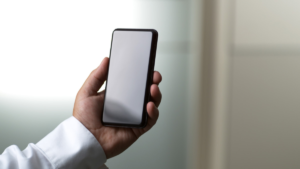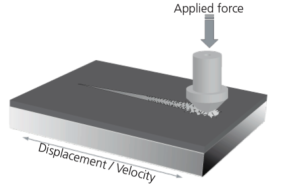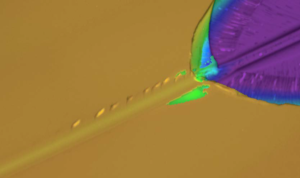Introduction
 Since its introduction in 2008, the Corning® Gorilla® glass has been an omnipresent glass in the smartphone’s screens. The introduction of the Victus® version of Gorilla® glass in 2020 shows that the development of such materials is a continuous effort.
Since its introduction in 2008, the Corning® Gorilla® glass has been an omnipresent glass in the smartphone’s screens. The introduction of the Victus® version of Gorilla® glass in 2020 shows that the development of such materials is a continuous effort.
The development of chemically strengthened glasses became necessary to combined scratch and impact resistance into a thin glass part capable of protecting the smartphones during their intense use. These glasses demonstrate surface strength, ability to contain flaws and scratch resistance. In addition of the consumer electronics that brought them to common knowledge, these products are also used in industrial, automotive, aviation, architectural and pharmaceutical applications.
Testing Problematic
The smartphones require a thin glass screen capable of being swiped multiple times and survive being stored with other damaging items such as keys. The glass manufacturers are investing in research that can lead to stronger and more scratch resistant materials to be used by smartphone manufacturers. The quality of a good chemically strengthened glass therefore resides in its ability to resist scratching by particles or items that will come in contact with its surface.
The challenge of using a generally brittle material such as glass is that one must increase its elasticity and reduce its brittleness at the same time to achieve the functionality required for its applications. Although scratch testing is an obvious choice to test the scratch resistance of these products, this test can bring researchers much more information than just the scratch resistance. Therefore, scratch testing presents clear advantages for researchers and quality control engineers to improve and control these glass products.
Principles of Testing
A scratch is created by dragging a diamond tip of known geometry atop the surface of the sample of interest as shown in Figure 1. As the tip is moved along the surface, the normal load applied to the tip is increased linearly, creating an increase in the severity of the contact. Following the scratch, images are taken of the entire scratch to analyse the different deformation and failures. The normal loads at which failures happen are called critical loads1,2. Critical loads are found using either imaging or a combination of imaging and signals (Acoustic emission for example). Multiple signals can be recorded during the scratch test, allowing the user to correlate behaviours and specific measures.


Conclusion
The scratch testing technique was used to simulate a “worst case” scenario for the wear and damage of chemically strengthened glass such as Gorilla® glass.
The stresses generated during the scratch test provide information on the strength of the different glasses and allow for the ranking of the different treatments used to produce those samples.
The combination of image and signal analysis provides the most advanced understanding of glass failure behaviours. The same instrument is also used to study wear on those same samples although those results were not reported here.
Click the button ‘request application note’ and download the full application note
